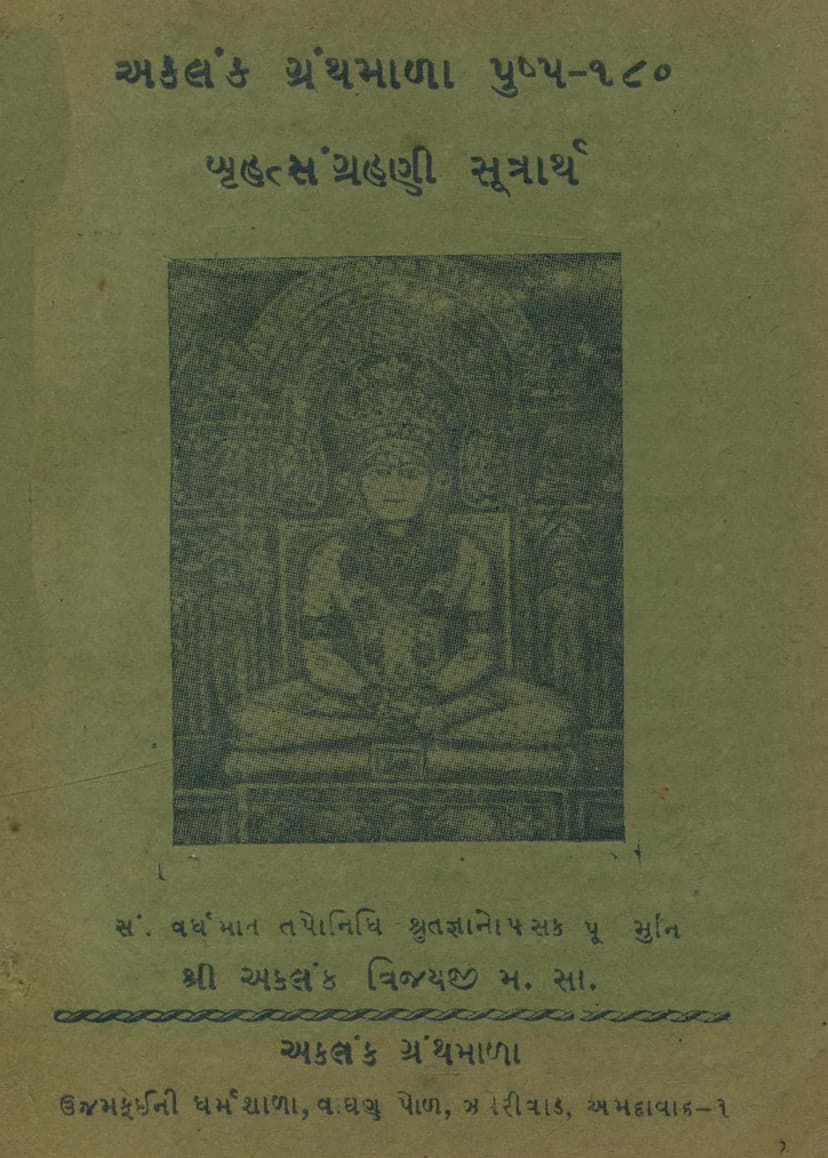Bruhat Sangrahani Sutrarth
Added to library: September 1, 2025

Summary
Here is a comprehensive summary of the Jain text "Bruhat Sangrahani Sutrarth" by Akalankvijay, based on the provided pages:
Book Title: Bruhat Sangrahani Sutrarth Author: Akalankvijay Publisher: Akalankvijay Granthmala Catalog Link: https://jainqq.org/explore/022145/1
This text, "Bruhat Sangrahani Sutrarth," published by Akalankvijay Granthmala as its 180th publication, is a detailed commentary (Sutrarth) on the Bruhat Sangrahani Sutra. The commentary is attributed to Muni Shri Akalankvijayji Maharaj, who is described as a repository of penance and knowledge.
Core Concept of Sangrahani: The term "Sangrahani" itself refers to a collection or compilation of important concepts within Jain scriptures. The text explains that a Sangrahani typically covers ten key elements: divisions (Khanda), measures (Yojana), regions (Kshetra), mountains (Parvat), peaks (Shikhar), sacred sites (Tirth), lineages (Shreni), realms (Vijay), impregnable fortresses (Dridh), and rivers (Nadi).
Distinction between Laghu and Bruhat Sangrahani: The text highlights that there are both a "Laghu Sangrahani" (Smaller Sangrahani) and a "Bruhat Sangrahani" (Larger Sangrahani). The Laghu Sangrahani, authored by Shri Haribhadrasuri, is found within the Pratikraman Sutras and is considered foundational.
Structure and Content of the Bruhat Sangrahani: The Bruhat Sangrahani, according to the introduction and subsequent explanations, delves deeper and provides a more expansive understanding of key Jain doctrines. It is considered more technical and is primarily for scholars and the learned.
The book is structured to explain fundamental Jain principles, offering insights into the nature of existence and the universe as understood in Jainism. Key areas covered or alluded to include:
- Cosmology and Geography: The Bruhat Sangrahani details the structure of the universe, including the Jambu Dwipa, and describes various celestial bodies, regions, and geographical features. It touches upon scientific knowledge embedded within Jain texts, referencing concepts like "Tamaskaya" (Black Hole) as an example of the advanced scientific understanding.
- The Three Worlds and Four Destinies: It provides descriptions of the three worlds (heaven, earth, and underworld) and the beings residing in the four destinies (Narak, Dev, Manushya, and Tiryanch). The text elaborates on the portals or "doors" related to each destiny, outlining a total of thirty-four such portals across the four realms.
- Life Forms and Their Characteristics: The book extensively describes the characteristics of various celestial beings (Devas) and hellish beings (Naraka). This includes details about their lifespan (from short to incredibly long, measured in millions of years), their birth process (upapat), their dwelling places (vimanas), and the nature of their happiness and suffering. It also touches upon the lifespan of beings in other realms.
- The Cycle of Birth and Death (Samsara): The text emphasizes the karmic principles that govern the transmigration of souls, explaining that all actions have consequences. It highlights the principle of "Parasparopagraha Jeevanam" (mutual dependence of living beings) from the Tattvartha Sutra.
- The Nature of Souls and Karmas: It explains the fundamental tattvas (principles) of Jainism, including the soul (Jiva), non-soul (Ajiva), merits (Punya), demerits (Paap), influx of karma (Ashrava), cessation of karma (Samvara), shedding of karma (Nirjara), bondage of karma (Bandha), and liberation (Moksha).
- Detailed Descriptions of Celestial Realms: A significant portion of the text is dedicated to detailing the various celestial realms, including:
- Bhavanpati Devas: Their lifespan, palaces, their kings (Indras), queens, and their respective symbols.
- Vyantar Devas: Their realms, lifespan, and their various classes and kings.
- Jyotishi Devas: Detailed descriptions of the sun, moon, planets, and stars, including their movements, distances, and lifespans.
- Vaimanik Devas: The various classes of Vaimanik heavens (Soudharma, Ishana, Sanatkumara, Mahendra, Brahmaloka, etc.), their lifespans, the number of their vimanas (celestial vehicles), and the arrangement of their celestial courts.
- The Structure of the Universe: It describes the cosmic geography, including the continents (Dvipas) and oceans, with detailed measurements and descriptions of their size and composition.
- The Realm of Hell (Naraka): The text provides a vivid description of the seven hellish realms, their inhabitants, their lifespans, and the types of suffering they endure due to their past karma. It details the structure of these realms and the specific causes of their suffering, emphasizing the consequences of negative actions like violence, dishonesty, and greed.
- The Importance of Knowledge and Conduct: The book underscores the importance of understanding the Jain principles for the spiritual well-being of every follower. It emphasizes the ultimate goal of attaining Moksha by eradicating karmas.
- Authoritative Lineage: The text traces the lineage of knowledge, stating that the Bruhat Sangrahani was originally taught by Lord Mahavir, compiled by his disciples (Ganadharas), described in the Pannavanna by Shri Shyamacharya (Kalkacharya), elaborated in the Bruhat Sangrahani by Shri Jinbhadra Gani Kshamashraman, and this particular version was composed by Shri Chandrasuri.
Purpose and Audience: The primary objective of the author, as stated in the text, is to benefit all living beings. The book aims to provide knowledge about the different realms and the beings within them, ultimately guiding readers towards the path of liberation by shedding karma. It is intended for those seeking to deepen their understanding of Jain philosophy and cosmology.
In essence, "Bruhat Sangrahani Sutrarth" serves as a comprehensive guide to the Jain understanding of the universe, the various classes of beings, their lifespans, their environments, and the underlying karmic laws that govern their existence, all presented with the aim of promoting spiritual upliftment.